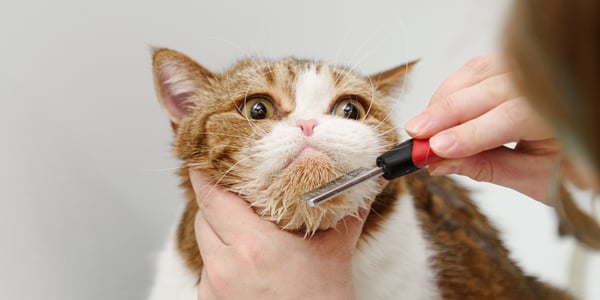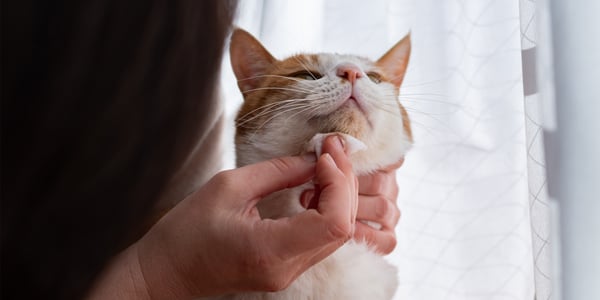Understanding Cat Acne: Chin Acne Causes, Symptoms and Treatment
Index:



Introduction
As a cat owner, you'll know that these animals possess an innate elegance, from the tips of their whiskers straight to their tail.
However, beneath that flawless fur and poise, our feline friends can encounter a common cat skin condition known as feline chin acne.
Understanding cat acne, discerning the symptoms of cat acne, and knowing the proper treatment for cat acne is paramount in ensuring your four-legged companion continues to thrive.
Often overlooked until the subtle 'dirt' on their chin can't be brushed away, cat chin acne is a condition that necessitates a deeper understanding and a gentle, caring approach.
Whether you're new to the world of cat care or a seasoned cat parent, join us as we explore the ways you can enhance the well-being of your cherished pet.
Key takeaways
Gain insights into the causes and triggers of cat chin acne.
Learn how to identify the symptoms of cat acne for early detection.
Understand the importance of a tailored treatment plan.
Discover proactive tips for cat care to prevent future outbreaks.
Establish when to seek veterinary advice for this common cat skin condition.



What causes cat acne?
Understanding the underlying factors leading to feline chin acne is crucial for preventing and managing this common dermatological issue in cats.
While the causes of cat acne are diverse and sometimes ambiguous, certain elements have been recognised as consistent triggers, influencing the proclivity of cats to develop this skin condition.
Understanding the common triggers of feline chin acne
Many cats prone to acne breakouts experience a disturbance in keratin production, leading to blockages in hair follicles.
Comedones, which are essentially blackheads, become visible on the cat's chin and lip areas. Acne usually appears in the form of these blackheads but may progress to pustules or severe infection if left unchecked.
How poor hygiene and stress contribute to cat chin acne
Stress is a known catalyst for various health issues in felines, including dermatological conditions.
A stressed cat is more susceptible to developing acne as stress can exacerbate sebum production and skin inflammation.
Similarly, poor hygiene, specifically in and around feeding areas, can introduce harmful bacteria to a cat's susceptible areas, triggering acne development.
Owners should maintain a clean environment and conduct regular grooming to help mitigate these factors.
Regular grooming and maintaining hygiene are paramount, and for holistic health, including parasite control, consider exploring our comprehensive guide to wormers for cats, which complements these efforts.
The role of diet in cat acne development
Dietary influences play a non-negligible role in the manifestation of feline acne. Certain foods may cause allergic reactions or sensitivities, leading to skin issues, including acne.
Ensuring a well-balanced, high-quality diet is essential for maintaining overall skin health and reducing the likelihood of acne flares.
Recognising the causes of cat acne is the first step towards effective management and treatment.
By addressing these contributing factors, cat owners can help their pets maintain healthier skin and reduce the incidence of acne outbreaks.
While addressing dietary influences to prevent feline acne, it's also crucial to understand the impact of diet on your cat's overall health.
Our ultimate guide to cat diarrhoea offers insights into how dietary choices affect your cat's well-being, highlighting the connection between internal health and skin conditions.



Symptoms of cat acne to watch for
Being vigilant about your pet’s health includes noticing changes in your cat’s skin, especially around their chin.
If you spot what seems to be dirt on your cat’s chin, it could actually be the initial signs of cat acne. These symptoms can range from mild to severe acne.
Identifying the first signs of chin acne in cats
The onset of your cat's acne might first manifest itself as small black dots, closely resembling blackheads found in human acne.
These are easily mistaken for specks of dirt. As the condition develops, the presence of acne on your cat’s chin becomes more apparent, taking the form of inflamed red pimples or even pustules, which indicate the beginning of a possible infection that necessitates closer attention.
Distinguishing cat acne from other skin conditions
Understanding how cat acne differentiates itself from other skin issues is crucial for effective treatment.
Distinguishing cat acne from other skin conditions is essential. For insights into other skin anomalies such as skin tags, our article on cat skin tags provides further clarity on the subject.
Unlike common dirt accumulation or other dermatological conditions that might affect your cat's skin, acne particularly targets the chin and can lead to painful swelling and persistent hair loss in the area. The typical telltale signs of redness accompanied by blackheads offer a unique pattern that doesn't correlate with the majority of other feline skin diseases.
Mild acne presents as dirt-like blackheads.
Moderate acne may evolve into red, inflamed pustules.
Severe acne can result in painful, swollen crusts and hair loss.
By recognising these symptoms promptly, cat owners can ensure their pets receive the appropriate care before minor skin irritation turns into a more dire condition.
Keeping a close eye on any changes in your cat’s chin will help maintain their appearance and health.



Exploring treatment for cat acne
When it comes to the treatment of cat acne, a multifaceted approach is often necessary to heal your feline friend.
For pet owners, understanding various treatment options can be valuable knowledge to ensure quick and effective management of this common condition.
Initial steps often focus on non-invasive methods, graduating to more aggressive treatment if conditions persist.
The most effective remedies for feline acne
At the core of any acne treatment plan for cats is improved hygiene. Regular cleansing with specially formulated shampoos or pads containing benzoyl peroxide can be crucial in reducing oil build-up and flushing clogged follicles.
Meanwhile, incorporating omega-3 fatty acid supplements may enhance skin health and resilience.
Acne treatment for cats might also include topical antibiotic ointments, providing a direct method to treat cat acne by targeting bacterial infections.
In more severe cases, the treatment often requires advancing to oral antibiotics, particularly if topical measures do not suffice. Here's a table outlining potential treatments and their considerations:
When to seek veterinary care for cat chin acne
Veterinary intervention becomes crucial when acne persists despite the initial remedies or if your cat displays signs of distress.
Acne can affect cats of any breed or age, and while sometimes it could be merely a minor nuisance, it could escalate into a painful condition if not adequately addressed.
If you notice exacerbated inflammation, pain, or spreading of the condition to the lips and mouth, it is time to seek an expert's guidance.
In these cases, a vet may prescribe a more aggressive treatment plan which can include potent drugs like isotretinoin for chronic issues. Remember, timely and professional advice is key to your cat's well-being.
At the core of any acne treatment plan for cats is improved hygiene. For a broader look at maintaining your cat's skin health, including addressing issues like dandruff, visit our article on banishing cat dandruff, which can be part of your strategy for a healthy, happy cat.



Conclusion
In summary, cat chin acne is a well-documented skin condition afflicting our feline friends. With a proactive stance on treatment and prevention, the impact on your cat's well-being can be significantly mitigated.
Integrating tips for cat care such as maintaining stringent hygiene, providing a balanced diet, and implementing regular grooming sessions are cornerstone methods in managing feline skin health.
Although the exact causes of this ailment may elude us, the signs are clear and the remedies, thankfully, within reach.
An intricate part of responsible pet ownership is understanding cat skin conditions to ensure they receive timely and effective medical attention.
Regular veterinary check-ups and keen observation at home will enable you to catch any irregularities in their infancy, reducing the likelihood of advancement and associated complications.
Should you notice your cat exhibiting any symptoms of cat chin acne that persist despite your best efforts of at-home care, we recommend seeking professional advice.
FAQs
Our feline friends sometimes face skin conditions that can be baffling to their owners. Among these is cat acne, a common issue that raises many questions about its nature and impact on our pets' well-being.
Let's delve into some frequently asked questions to better understand how to care for a cat's health when it comes to this peculiar skin concern.
Is cat acne contagious?
One prevalent question that pet owners often harbour is whether their cat's acne can spread to fellow felines. Rest assured, cat acne is not contagious.
This condition is related to the overproduction of keratin and blockages of hair follicles on the cat's chin, rather than a pathogen that can be transmitted to other cats.
Blackheads or whiteheads that you see are signs of these blockages and are no cause for concern regarding contagion.
How does cat acne affect my pet's health?
While typically a minor irritant, cat acne can sometimes escalate into more troublesome symptoms that warrant attention.
Most instances are superficial and will not significantly affect your cat's health, particularly with timely and proper treatment.
However, should the acne progress to a state where swollen lesions or scabs are present, discomfort can increase, and there is a risk of secondary infections.
To best protect your cat's well-being, it's essential to avoid squeezing or picking at the acne, as this can aggravate your pet's skin and lead to further complications.
Understanding these aspects of cat acne is invaluable for maintaining the health and happiness of our feline companions.
If you're ever in doubt about the severity or treatment of your cat's condition, it's always best to consult with a veterinarian for professional guidance.
Waggel members have access to a 24/7 video vet service to help you with issues such as these without having to physically visit the vet. Not a member? Get a quote today and see how much it would cost to protect your dog with Waggel Pet Insurance.
Waggel Pet Insurance
Need more help? You're in luck if you're a Waggel Pet Insurance member. Along with our excellent coverage, we offer access to a 24/7 online vet to answer all your sticky questions, especially if you need grooming assistance.
Not a member? Why not get a quote now and cover your furry friend for a range of illnesses, all while enjoying our amazing perks and rewards.
Want more like this?
Get updates from us with helpful info, advice, answers to frequently asked questions and much more.
Index:
Related posts:
Get your quote
Along with our excellent coverage, we offer access to a 24/7 online vet to answer all your sticky questions.





